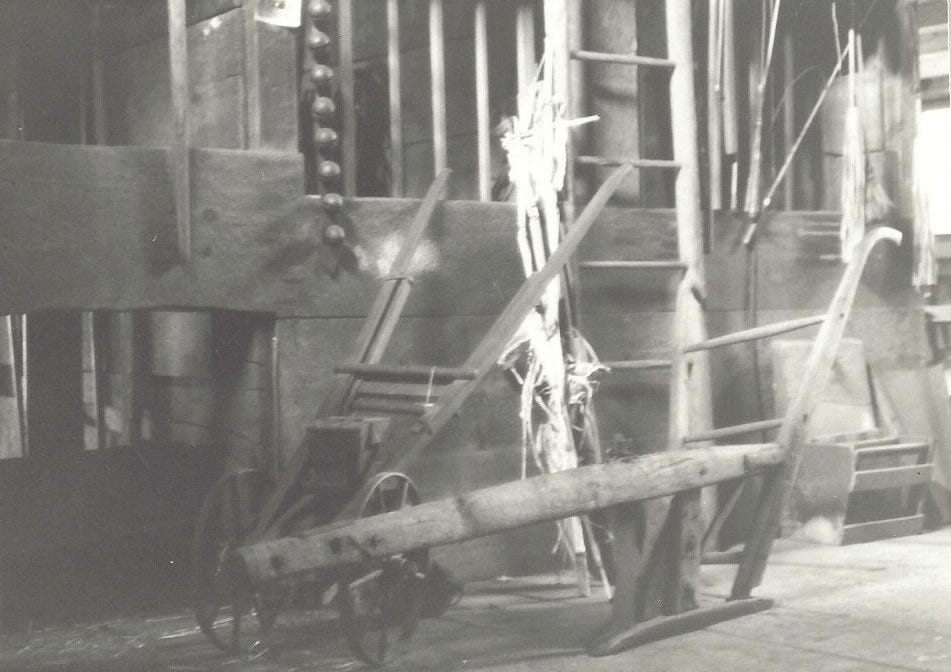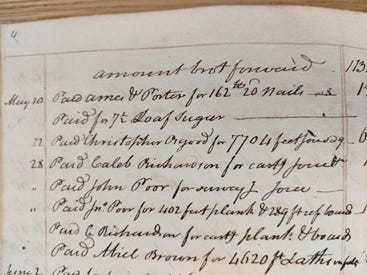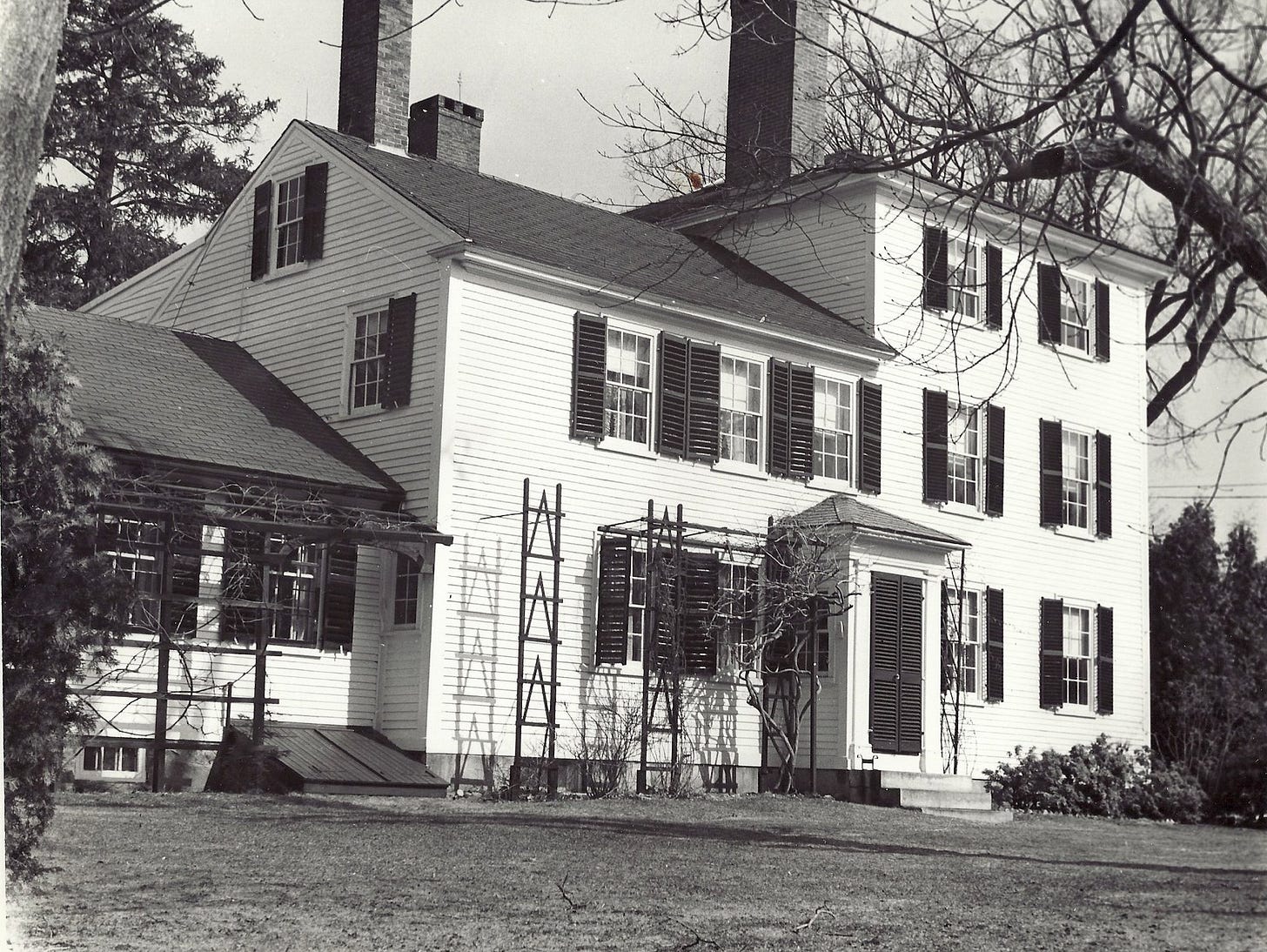If you like this story, please comment, like, share, and subscribe!
The History Center has called the Blanchard home since 1929.
The Amos Blanchard House & Barn
In 1818 and 1819, Amos Blanchard, a successful businessman and Deacon of the church, bought two adjoining pieces of land along the Essex Turnpike in Andover for the princely sum of $530. He purchased one parcel from the South Church and the other from the Rev. Justin Edwards.
In his ledger book, Blanchard recorded the purchase of the land along with detailed accounts of the cost of building his house and barn. The ledger is in the archives of the History Center.
“Building a Barn”
In July 1818, Blanchard contracted with Captain Amos Holt to build the barn for $275. The cost of nails, hinges, and underpinning brought the construction price to $320. The barn was built to house a small number of animals to support the family. Tax records of 1820 show that the Blanchards owned just one horse and one cow.
Built in the style of an “English barn,” Blanchard’s barn was originally a three-bay, 34’x28’ structure. An additional 4th bay was added by 1828 as recorded in Blanchard’s fire insurance policy.
Planks, nails, paint, and sugar
Over the 18 months it took to build the house, Blanchard kept meticulous records of the construction. Some items from his ledger include:
1819 Feb 2 Paid Levi Family for 100 ft. underpinning $55.00
Apr 26 Paid Flagg & Gould for glass 119.87
June 2 Paid for paint, spikes, & oven door 16.00
June 17 Paid for 140 lbs of sheet lead 17.53
A loaf of sugar also made it to the ledger.

Finishing the house
CORRECTION: After this story was originally posted, I discovered that I had perpetuated a mistake by reporting that Amos Blanchard’s journal included 42 1/2 gallons of rum. That number came from an exhibit label that had been copied erroneously many times over (and since corrected).
The number Amos Blanchard wrote in his journal was “13 gall NE Rum.”
The entry is one of the last in Amos Blanchard’s list of expenses, so it could have been to celebrate, or he could have distributed the rum as payment or thank you to the workers who built the house.
13 gallons of rum is still a lot of rum. For perspective on this quantity of alcohol, please visit the Resources listed at the end of this post to read a portion of “Alcohol in America” by W.J. Rorabaugh, published in 1991 in the OAH Magazine.1
Americans consumed huge quantities of liquor in the early 1800s, including gin, whiskey, rum, and brandy. Indeed, scholars agree that the rate of consumption of these drinks during the first three decades of the 1800s reached levels that have never been equaled in American history.2
Blanchard made this note in his ledger:
Tuesday, Jun1, 1819. Raised the House
Finished work, Saturday Oct. 30, 1819
Wed., Nov. 10th 1819. Moved my family to the new house.
Whole expense of Homestead $4100.00
The History Center is in the middle of a restoring the Blanchard house and barn to its late 20th century century appearance. Although Deacon Blanchard would find the difference in cost staggering, we’re honored to be the caretakers of his home.
If you would like to learn more about work on the Blanchard house and barn visit the History Center’s website.
Thanks for reading! If you enjoyed this post, please like and share! Leave a comment and let us know what you think.
Resources
W.J. Rorabaugh, “Alcohol in America,” OAH (Organization of American Historians), Magazine of History, Fall, 1991, Vol 6, No. 2, Drug Use in History (Fall, 1991) pp.17-19, Published By: Oxford University Press.
Available through JSTOR https://www.jstor.org/stable/25162814
Page 17
For centuries Europeans have downed large quantities of beer, wine, and hard liquor. When Europeans began to migrate to North America in the early 1600s they brought along their hearty drinking habits. Thus Americans have been heavy users of alcohol for more than three hundred years.
English colonists in Massachusetts and Virginia imported beer, but this was ex pensive, and for a time they brewed their own. After 1700 the colonists " drank fermented peach juice, hard apple cider, and rum, which they imported from the West Indies or distilled from West Indian molasses.
Virginians had a carefree attitude about alcohol. Drinking was an important part of the culture, and people passed around jugs or bowls of liquor at barbecues, on market days, and at elections. Candidates gave away free drinks. A stingy candidate had no chance of winning. Practically everyone drank.
Even restrained New Englanders consumed great quantities of liquor. The Puritans called alcohol the "Good Creature of God," a holy substance to be taken proudly yet cautiously. Though unopposed to the use of alcohol, New England ministers did declare public drunkenness a sin that led to poverty, crime, and violence, especially wife beating.
By 1770 Americans consumed alcohol, mostly in the form of rum and cider, routinely with every meal. Many people began the day with an "eye opener" and closed it with a nightcap. People of all ages drank, including toddlers who finished off the heavily sugared portion at the bottom of a parent's mug of rum toddy. Each person consumed about three and a half gallons of alcohol per year. This is about double the present rate of consumption.
The American Revolution drastically changed drinking habits. When the British blockaded the seacoast and thereby cut off molasses and rum imports, Americans looked for a substitute. Scot-Irish immigrants who had settled on the western frontier provided whiskey.
After the revolution whiskey replaced rum, since the British refused to supply it and the new federal government began to tax it in the 1790s. Whiskey also thrived because it was cheap. The settlement of the corn belt in Kentucky and Ohio created a corn glut. Western farmers could make no profit shipping corn overland to eastern markets, so they distilled corn into "liquid assets." By the 1820s whiskey sold for twenty-five cents a gallon, making it cheaper than beer, wine, coffee, tea, or milk. In many places whiskey was also less dangerous than water, which was frequently contaminated. By 1830 consumption of alcohol, mostly in the form of whiskey, had reached more than seven gallons a year for every person over age fifteen or three times the current rate.
Liquor tended to be taken in small quantities throughout the day, often with meals. Instead of a morning coffee break, Americans stopped work at 11:00 a.m. to drink. A lot of work went undone but in this slow paced, preindustrial age this was not always a problem. A drunken stage coach driver posed little threat, since the horses knew the route and made their own way home. However, there was growing opposition to alcohol.
Page 18
By 1850 the consumption of alcohol had dropped by more than half. This decline did not mean that the average American drank only half as much. Rather, half the population had stopped drinking. Other people continued to drink as they had before the temperance movement.
As early as the 1830s temperance leaders resorted to government power to coerce the remaining drinkers to give up liquor. Temperance became prohibition, and in 1838 Massachusetts passed the first prohibition law.
https://www.pastemagazine.com/drink/alcohol-history/the-1800s-when-americans-drank-whiskey-like-it-was/












Interesting comments about alcohol consumption in those days, in this case for a special celebration. While you make clear the volume of alcohol, the price (including in today's $$) is unclear. And how many people might have joined the party (Andover population?)? And what was alcohol % back then? And how long did party last? So what was alcohol consumption rate, per person (per day?) for such a "celebration"? Push the numbers further & see what they suggest, esp. relative to today's alcohol consumption rates. Help readers understand how drunk these people were. And what % of building expenses were for the wild party at the end? Were such (drunken?) parties common in those days?